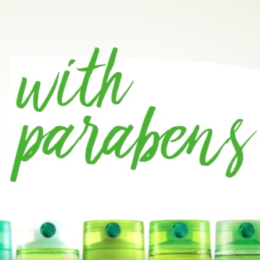Shoppers Want Parabens – But Have No Idea What Parabens Are

In recent years, activist groups have spent millions of dollars convincing consumers that the chemicals lurking in their cosmetics pose an unreasonable risk to human health.
The narrative isn’t true –as any elementary school science teacher can tell you, everything in the world is made of chemicals. And the vast majority of substances you encounter every day won’t hurt you. But do consumers see through the activist scaremongering? We decided to find out by gauging consumer opinions on parabens.
Parabens are chemicals added to shampoos, lotions, makeups and other personal care products to prevent bacteria and fungus from calling your toiletries home. They’re an incredibly useful ingredient when you consider the average person has 150 different species of bacteria living on each hand. Although the vast majority of bacteria won’t make you sick, no one wants to risk swiping on a layer of Staphylococcus (the group of bacteria responsible for staph infections) with their lipstick.
But organizations like the Environmental Working Group – which raised $11.8 million promoting the fear of chemicals in 2015 alone – claim parabens can disrupt hormones and cause breast cancer. EWG labels every paraben found in personal care products as a moderate or high hazard ingredient. But here’s the thing: lab tests show parabens are 10,000 to 100,000 times weaker than the main estrogen in the human body. The US, Canada, and Europe all believe the amount of parabens in cosmetics today don’t pose any risk to human health. But advocacy groups have pressured companies into believing that no one will buy products containing parabens, and “paraben free” labels have begun popping up on cosmetics nationwide.
To get to the bottom of consumer trust for parabens, we constructed two surveys. Respondents viewed one of two near-identical commercials: one advertising a shampoo with “no parabens,” and another advertising it “with parabens.” (For the record, the shampoo featured does NOT contain parabens.)
Adult women who viewed the “with parabens” commercial were 4 percent more likely to indicate an interest in buying the product. Not a large spread, but a clear indication that perhaps consumers are seeing anti-chemical scare tactics for the farce they are!
Or not.
When we asked those who avoid parabens why they choose to shop paraben-free, women cited “Parabens are not natural ingredients” most frequently (35.6 percent). And they’re half right: parabens occur naturally in some fruits and vegetables, but the most common parabens used in cosmetics are created in a lab. A similar number of respondents (31.9 percent) believe parabens negatively impact health.
But “natural” doesn’t mean better or safer any more than “synthetic” means dangerous. Activist organizations simply exploit the unfamiliarity of scientific-sounding names in order to keep beating the drum that all chemicals are dangerous all the time. Perhaps the next time someone accuses you of spreading your cold, you should remind them that it’s ok – viruses are only natural.
Interestingly, “Parabens are natural” was the second most popular reasoning (13.0 percent) among women who indicated an interest in purchasing shampoo with parabens. Cost was the biggest factor, at 26.5 percent. Unfortunately for chemists, it seems mere suggestion – claiming an ingredient is natural or not — has a profound impact on interest.
So what’s the final verdict on parabens?
According to science, parabens shouldn’t make you afraid to wash your hair. And according to our poll, consumers seem just as receptive to shampoo “with parabens” as without.
So if parabens are doing good for consumer health and activist scaremongering hasn’t convinced shoppers to run for the shampoo-free hills, what’s the issue? Perhaps if popular brands took their guidance from science instead of activist pressure, we could actually see commercials advertising parabens as a good thing.





